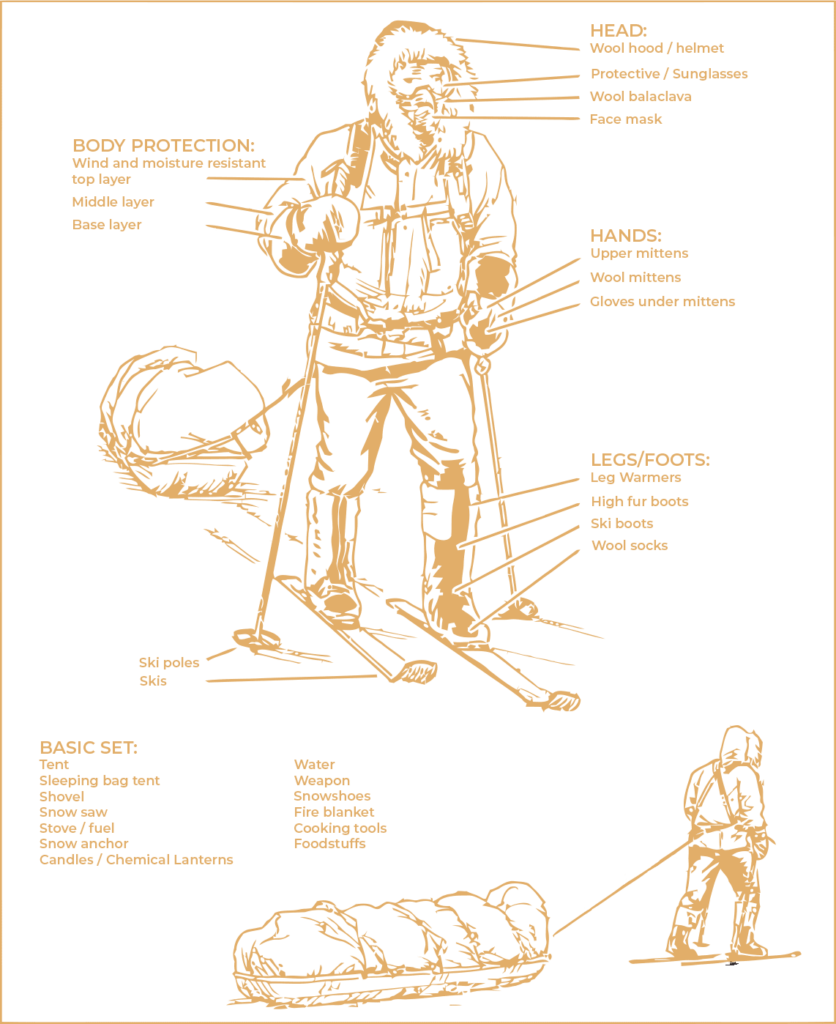EQUIPMENT FOR THE NORTH
Among the military personnel making marches with sacks weighing more than 60 kg on their backs in the North, the phrase is widely known: “A lightweight sack is, of course, easier to carry, but at night you will freeze.” It is fully true and for tourists traveling in winter, and for adventure seekers in the arctic terrain. In the daytime, it is possible to maintain a normal body temperature by moving over rough terrain with slopes of the order of 20 °. However, at night, when the temperature drops much below freezing, and you are at rest, it becomes much more difficult to keep warm. Therefore, it is better to be safe than sorry.
Put all the necessary items in a low, wide, closed-bottom sled. You will consume less energy by dragging this load along the snow and ice, rather than carrying it on you. Getting the most effectly out of your energy will help you stay away from hypothermia for longer.
Equipment and stock
The Arctic is ruthless: in terms of the negative impact on humans, the natural conditions there can only be compared with a scorching desert. The importance of properly preparing for large temperature extremes and meeting food and fuel needs in these harsh conditions cannot be overemphasized. The temperature range, the risk of avalanches and other weather conditions should be determined in advance. This will help you to choose and pack your equipment correctly and plot the route on the map. Navigation devices should include a compass and a GPS device, and you should also take maps with you. If something goes wrong, there must be a replacement. Sunglasses are a must, as the dazzling sunlight reflecting off the snow makes it very difficult to navigate the terrain. Such conditions are difficult for vision, and photokeratitis – a painful eye burn, also known as sun blindness, can occur. If skiing becomes impossible, use a snow anchor and a pair of snowshoes. They distribute body weight over a wider area, thereby reducing the risk of falling into the snow. If the snow cover reaches your waist, you will waste hundreds of precious calories to overcome just a few meters.
When driving on a steep incline, use a snow anchor to brake in the event of a downward slide. Learn to use it before you even travel.
For the jungle, the kukri knife was indispensable, and in the arctic conditions, the same valuable tools that can be used for a variety of purposes are a snow saw and a shovel. With their help, you can catch something for lunch, build a shelter, or overcome an unexpected obstacle.
In addition to a insulated tent for cold weather and a well-insulated sleeping bag for overnight stays in low temperatures, you will need a sleeping bag-tent with an outer layer of thin but dense fabric. In order to avoid any serious consequences, it is necessary to preserve the heat generated by the body as much as possible, and for this it is necessary to pack himself as best as possible. A thick travel mat, which, like a sponge, absorbs the precious heat you radiate, will protect you from the cold ground. A fire blanket folded in several layers will also provide the necessary insulation if you need to warm up quickly. Use a few candles to raise the temperature inside a tent or snow shelter by a few degrees.
Remember to extinguish them before bed to avoid possible fires.
Food stocks must be sufficient. At low temperatures, the body burns almost twice as much fuel as under normal conditions. Therefore, you need foods that are high in fat. In addition to prepackaged dehydrated foods and energy bars, it worth to take peanut butter, lard, nuts, and chocolate. When your metabolic system is working harder than usual to convert food into heat to sustain life, there is no need to talk about extra calories. Keep in mind that the extra energy is required for towing heavy sleds and for potentially long walks in which you can get hungry and lose weight quickly if your calories aren’t enough.
The best option for health is consuming 5,000 or more calories per day, plus an additional “emergency supply”.
You must have a water filtration device with you. In emergencies, snow and ice can be used with minimal risk. But water, especially from rivers or lakes, is recommended to be filtered.
Today, specialist retailers and backpackers offer a variety of items that will enhance your comfort level in cold weather. Consider the weight of these items, because during the hike you will have to carry or drag them.
Clothes
The main protection against cold in arctic conditions is a multilayer system that does not allow wind and frost to reach the body and accumulates the heat generated by it. But even thick and porous layers of fleece and lining will not solve the problem if the garment is not buttoned correctly, that is, it does not provide the necessary insulation. The outer layer of clothing becomes important, it’s characteristics should be the best. Choose a gortex-type material for cold weather that does not let heat through, but a little breathes.

Unlike materials with zero porosity, this breathability promotes perspiration drying. In cold climates, important to keep not only warmth, but also dryness of the skin, since in these conditions the moisture on the skin quickly freezes. Wet socks will quickly lead to tissue death, as the narrowing of the lumen of the blood vessels prevents blood from flowing to the legs. In addition, wet feet lose 25 times more heat than dry feet. Even in warm but humid climates, cotton socks can be detrimental. And even more so, wet woolen socks will not protect you from the appearance of a trench foot.






